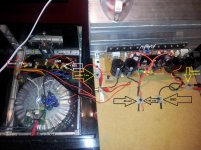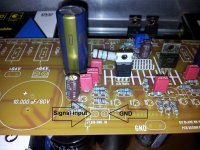That's the problem with the method advised by DX.
He does not appear to understand the operation of any of the amplifiers he has "guaranteed" to work.
He does not appear to understand the operation of any of the amplifiers he has "guaranteed" to work.
Patrick, that is what Rudy is doing currently.
Rudy: did you proceed as Andrew told you?
Remove the 10R resistors that you have soldered across the fuseholders and insert the recommended fuses.
Leave the input+ connected to GND and do not yet connect a speaker to the AMP.
Switch power on and once more do the required adjustments.
This time without "fuse resistor".
Without it the rail voltage has changed (has become bigger) - this is why.
Watch the AMP a while (several minutes).
Does the quiescent current remain stable?
Then: power off.
Do you have a pair of very cheap speakers?
Do you have a source with volume attenuator?
Do you have a bottle of whisky?
Rudi
Rudy: did you proceed as Andrew told you?
Remove the 10R resistors that you have soldered across the fuseholders and insert the recommended fuses.
Leave the input+ connected to GND and do not yet connect a speaker to the AMP.
Switch power on and once more do the required adjustments.
This time without "fuse resistor".
Without it the rail voltage has changed (has become bigger) - this is why.
Watch the AMP a while (several minutes).
Does the quiescent current remain stable?
Then: power off.
Do you have a pair of very cheap speakers?
Do you have a source with volume attenuator?
Do you have a bottle of whisky?
Rudi
Tomorrow after work I go further than it is weekend and can drink whisky and smoke a cigar;
Tomorrow I do:
1. Remove the 100R resistors soldered across the fuse holders.
2. Leave the input+ connected to GND and do not yet connect a speaker to the AMP.
3. Switch power on and once more do the required 1mv adjustments.
4. power off.
5. Remove the input+ connected to GND and connect very cheap speakers
6. Connect preamp.
7. Power on.
8. Listen to music and make ASAP the other amplifier
Regards,
Rudy
Tomorrow I do:
1. Remove the 100R resistors soldered across the fuse holders.
2. Leave the input+ connected to GND and do not yet connect a speaker to the AMP.
3. Switch power on and once more do the required 1mv adjustments.
4. power off.
5. Remove the input+ connected to GND and connect very cheap speakers
6. Connect preamp.
7. Power on.
8. Listen to music and make ASAP the other amplifier
Regards,
Rudy
Last edited:
The measurement is done and had the same values.
Am now as far as I have a cheap speaker connected with a preamp.
I get to hear a hum and receive music in the background.
If I touch the large heat sink changed the hum also with the small heat sink.
The output connector of the preamp is isolated the entrance connector of the power amplifier is also isolated.
Please tell me what is wrong, maybe the isolated input connector?
Regards,
Rudy
Am now as far as I have a cheap speaker connected with a preamp.
I get to hear a hum and receive music in the background.
If I touch the large heat sink changed the hum also with the small heat sink.
The output connector of the preamp is isolated the entrance connector of the power amplifier is also isolated.
Please tell me what is wrong, maybe the isolated input connector?
Regards,
Rudy
The Main Audio Ground is the reference point for a whole series of other circuits.
Signal Return
Speaker Return
PSU Zero Volts
Chassis
PCB Power Ground
Disconnecting Network, if fitted
You stated earlier that you had located your Main Audio Ground on the Speaker Return Terminal.
That means you must bring all the other reference connections to that same Terminal.
But, which Speaker Return Terminal do you use? Left or Right?
Andrew that means I must bring all the other (preamp cinc connector) earth/chassis connections to the same GND Terminal to the powersupply.
Regards,
Rudy
Last edited:
In the pictures, I didn't see any evidence that the center-tap of your main transformer was conencted to the reference ground, this may induce big offset...
Last edited:
This Is the good connection?
Nope, based on photo left side is GND-Signal ground and right side is IN.
He is playing, without hum that is good, but have a lot of white noise.
My preamp has a volume control with steps, each step give a crack on the speaker.
Now I need the 10R resistor?
Regards,
Rudy
My preamp has a volume control with steps, each step give a crack on the speaker.
Now I need the 10R resistor?
Regards,
Rudy
Why I have so much white noise on the speaker?
Here you all can see the video, is uploading now: http://www.youtube.com/watch?v=-DkBBjBpQME
Regards,
Rudy
Here you all can see the video, is uploading now: http://www.youtube.com/watch?v=-DkBBjBpQME
Regards,
Rudy
Last edited:
sssssssssssshhhhhhhhhhhhhhhhhhhhhhhhhhhhhhhhhhhhh noise ...  Gain ...? video is being processed !!!!!
Gain ...? video is being processed !!!!!
 Gain ...? video is being processed !!!!!
Gain ...? video is being processed !!!!!- Status
- Not open for further replies.
- Home
- Amplifiers
- Solid State
- Dx Blame MKIII-Hx - Builder's thread


 Wanye you have a way with words
Wanye you have a way with words